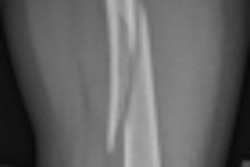A study at Massachusetts General Hospital (MGH) in Boston has found that acute adverse reactions to gadolinium-based contrast agents are rare. But MGH researchers caution radiologists to remain keenly aware of the risks associated with nephrogenic systemic fibrosis (NSF), according to the February issue of the American Journal of Roentgenology.
Although researchers found the frequency of adverse reactions from the contrast agents to be less than 1% of total administrations, lead author Dr. Hani Abujudeh, director of quality assurance at MGH, was reluctant to describe the incidence rate of contrast reactions as low.
"Low is relative. To each patient, it is a big deal," he said. "I don't want to characterize [the results] as low or high. These are the numbers we got."
At MGH, gadopentetate dimeglumine and gadobenate dimeglumine have been the primary gadolinium-based contrast agents used for MRI examinations. The agents were typically given at a standard dose (0.1 mmol/kg). Double or triple doses (0.2-0.3 mmol/kg) were used for MR angiography. All doses were administered as a bolus by hand or power injection (AJR, February 2010, Vol. 194:2, pp. 430-434.)
Imaging protocols
"In the past, we thought that gadolinium was safe, and the only question was whether or not the contrast reactions were moderate or severe. Now we have the issue with NSF, and all these drugs have what you would call 'negatives' and 'positives,' " Abujudeh said. "With gadolinium, we have the added 'negative' potential of NSF. So, when people make a decision to give gadolinium to patients, we have to figure out what is the rate of contrast reactions with each medication and weigh that with the risk of NSF."
As standard procedure, MGH evaluates its patients before gadolinium-enhanced MRI examinations and inquires about symptoms before and immediately after contrast administration and before discharge.
"We don't give [gadolinium-based contrast agents] anymore to patients who are in dialysis, because those are the patients with the highest risk, and we limit the amount of gadolinium that we give to patients with dysfunctional kidneys, but [who are] not on dialysis yet," Abujudeh said.
Researchers retrospectively analyzed the number of administrations of and acute adverse reactions to gadopentetate dimeglumine and gadobenate dimeglumine at MGH from October 2007 to December 2008.
During that time, 32,659 administrations of gadolinium-based contrast agents were given for MRI examinations. Of that total, 27,956 administrations (86%) were gadopentetate dimeglumine, and 4,703 administrations (14%) were gadobenate dimeglumine.
Adverse reactions
The researchers found 51 cases of acute adverse reactions to either of the two gadolinium-based contrast agents during the 15-month study period. Reactions occurred in 50 patients, which included 16 men and 34 women with a mean age of 48, ranging from 17 to 83 years. One patient experienced two episodes of mild averse reactions to gadopentetate dimeglumine. Of the 51 reactions, 43 were classified as mild, six were deemed moderate, and two were severe cases.
Gadopentetate dimeglumine was associated with 38 adverse reactions or 0.14% of the total number of administrations of the agent. Thirty-six of the 38 cases were considered mild, requiring either observation only or diphenhydramine administration.
The other 13 adverse reactions were associated with gadobenate dimeglumine, accounting for 0.28% of the total. Seven of these reactions were mild, four were moderate, and two were severe.
|
|||||||||||||||||||||||||||
| Source: AJR and Dr. Hani H. Abujudeh. | |||||||||||||||||||||||||||
The clinical significance of the adverse reaction rate, Abujudeh said, is "to know how those percentages weigh the negatives and positives with other drugs and a cross comparison between the different drugs" when making imaging decisions for a patient.
Frequent symptoms
The study also showed that the most frequent symptoms were hives and rash, as well as nausea. Forty-five of the 51 cases (88%) were handled in the radiology department, while six reactions (12%) were managed in the emergency department, with five of those six patients discharged on the same day.
Further study
Abujudeh and colleagues plan to continue their research, gathering more patient data on the use of the contrast agents and their potential for adverse reactions.
"We need to do more studies with a larger number of patients to continue to study the possible association between gadolinium-based contrast agents and NSF," he added. With only some 5,000 patients having been given gadobenate dimeglumine, "we need more investigation and more numbers with that" contrast agent.
Results from the retrospective nature of the study might underestimate the rate of contrast agent reactions compared with the rates reported in prospective, blinded, randomized controlled trials, the authors noted.
The study was based on the number of gadolinium-based contrast administrations, rather than the number of patients. "The number of patients likely was smaller, because patients probably underwent more than one contrast administration during the investigation period," the authors wrote. "We believe that this small bias is not significant given the large sample size in our investigation."
By Wayne Forrest
AuntMinnie.com staff writer
January 22, 2010
Related Reading
Italian researchers cut gadolinium dose -- as well as NSF risk, January 21, 2010
FDA panel: NSF incidence falls with gadolinium restrictions, December 9, 2009
MRI contrast media switch eliminates NSF cases, October 15, 2009
Mayo study finds few serious reactions to CT and MRI contrast, September 21, 2009
Gadolinium-based contrast agents alone don't cause NSF, study finds, July 8, 2009
Copyright © 2010 AuntMinnie.com



















